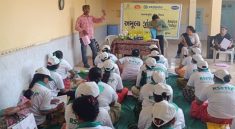In the arid landscape of Barmer, a beacon of hope was taking shape. The Barmer Unnati project, a visionary initiative to revitalise the region’s natural resources, had chosen Chitar Ka Par Gram Panchayat as its canvas. A remarkable transformation was underway on 5 hectares of arid land.
Inspired by the Miyawaki model, a revolutionary afforestation technique, 1451 diverse plant species were carefully selected and nurtured. The barren ground was rejuvenated with a vibrant tapestry of green, its once desolate appearance giving way to a thriving ecosystem.
But the project’s ambitions extended beyond mere afforestation. A dedicated patch of Sewan and Dhaman grass, renowned for its high nutritional value, was established. This lush green carpet promised to alleviate one of the most pressing challenges local farmers face – the scarcity of fodder for their livestock.
Day after day, the Sewan and Dhaman grass flourished, yielding a generous harvest of 300 kg of fresh, nutritious fodder. This bounty was a lifeline for the Chitar Ka Par Gowshala, a local cattle shelter. The cows, once struggling to find sustenance, now thrived on the abundant supply of green fodder, their health visibly improving.
The benefits of the Barmer Unnati project extended far beyond the Gowshala. By empowering local farmers with a sustainable source of fodder, the project alleviated their financial burden and enabled them to maintain healthier cattle. This, in turn, contributed to the community’s overall well-being, as farmers could generate higher incomes from their livestock.
As the project continued to bear fruit, it symbolised hope and resilience. It demonstrated that human ingenuity and determination could create a greener, more prosperous future even in the harshest of environments. The Barmer Unnati project was not just about planting trees; it was about planting the seeds of a sustainable tomorrow that would benefit future generations.
Contributed by Nishant Gaur










